Beetlejuice isn’t the most kid-friendly source material. The two main characters are a couple who tragically died in a car accident and now have to learn to cope with being dead. The titular character — who only occupies 17 minutes of screentime — is an evil, unscrupulous ghost that tricks the main characters into letting him torture an innocent, if annoying, family. He also, most horrifically of all, nearly marries a 16-year-old girl against her will.
Still, in the ‘80s and ‘90s, it was perfectly normal to adapt an adult film into a Saturday morning kids cartoon. (See also: Rambo, RoboCop and various Jim Carrey films.) Which is why Beetlejuice, despite its subject matter, was ripe for an animated adaptation. Of course, things had to be toned down. The Maitlands (Alec Baldwin and Geena Davis in the film) were removed entirely, and all references to “the afterlife” were substituted with “the neitherworld.” Beetlejuice himself would also become less nefarious and more of a goofy, magical troublemaker who loved puns and shapeshifted his body to sell a joke. And Lydia was aged down to a tween to better appeal to a younger demographic. (All of this was done in concert with Tim Burton, who greatly influenced the show’s look and style of humor.)
No matter the changes, the Beetlejuice cartoon proved to be a big hit. It won an Emmy and ran for three seasons on ABC before moving over to Fox Kids’ for a much longer fourth season of 65 episodes. And needless to say, it’s still remembered fondly all these years later. Thirty-five years later, to be exact. In fact, the 35th anniversary of its premiere (September 9, 1989) almost perfectly coincides with this weekend’s release of Beetlejuice Beetlejuice.
Don’t Miss
To properly mark the occasion, we gathered the most prominent behind-the-scenes players to share all of their favorite ghost with the most stories.
Summoning Beetlejuice
Michael Hirsh, co-founder of the Canadian animation company Nelvana, and author of Animation Nation: How We Built A Cartoon Empire: We first heard about the prospect of a Beetlejuice cartoon from our friends at ABC, who we were doing a lot of cartoons for in the 1980s. We all loved the movie, so we decided to go after it with Tedd Anasti and Patsy Cameron, a husband-and-wife team we had under contract.
Patsy Cameron, co-showrunner of Beetlejuice: My husband and I had done Disney’s DuckTales, then we got hired by Nelvana to be vice presidents of development for them. Our very first assignment was when Warner Bros. was thinking about doing a cartoon based on Beetlejuice. Each studio sent their development executives to watch the movie. Next, each studio sent their heads of development to have a meeting with Tim Burton and some of the executives from Warner Bros.
Hirsh: The first meeting was with Tim Burton when he was preparing for Batman. I remember he sat on a chair, but instead of sitting on a chair the way you’d normally sit on a chair, he was perched on the chair.
Tim was familiar with a movie we had made called Rock & Rule. He was also familiar with what we had done with Ewoks and Droids. Also, our studio had started as a stop-frame animation studio, and he had done his 1984 Frankenweenie short as stop-frame, so we got on the same page pretty quickly. Most of all though, we were like-minded in that we came at the project in terms of quality and the quality of the animation, as opposed to coming at it from the most commercial of eyes.
Tedd and Patsy came up with an approach that Tim thought worked really well, as it put the emphasis on the metamorphosis of Beetlejuice.
Cameron: During our pitch, Tedd and I acted out these silly scenes with him imitating Beetlejuice. We had a lot of plays on words too. Everything we said, Tim Burton and the executives threw their heads back and laughed.
A few days later, Stan Blum, who was in charge of marketing, said, “We got it!” I said, “I think I’m going to cry.” Then he said, “Well, we almost got it. Tim Burton loves you guys, but he’s going to London to film Batman, so he wants you to fly to London to keep talking about what your ideas are for Beetlejuice.”
We flew to London, and my husband, Michael Hirsh and I spent 10 days meeting with Tim, going over ideas and creating new characters. Finally, after a week, Michael Hirsh told us, “I’m running out of money. I have to know if he wants us or not. You have to ask him now, ‘Do you want us?’” I chose my husband out of the two of us to do the asking.
We met on the set of Batman. While Tim was leaning against the Batmobile, Tedd said, “Tim, I have to ask, do you want us?” Tim said, “Well, to tell you the truth, I want you guys.”
Hirsh: There was an issue though — Warner Bros. wanted us to give back our rights to Batman first. We had a Batman development deal that had stemmed from two years earlier. We had developed it too, but the network we had developed it with wasn’t buying in, and I’d shopped it around to the other networks and they’d passed as well. Nobody was expecting the Batman movie, which hadn’t yet come out, to be a big hit. So we were basically told, “You can have Beetlejuice. Tim has chosen you. But we have the final choice, and we’re not going to give it to you until you give Batman back.”
It was a tough Hollywood deal, but it worked out in the sense that Beetlejuice won us our first Emmy at Nelvana.

Designing the Dead
Hirsh: Another reason why we got Beetlejuice was because we had a great director and visual designer in Robin Budd. Robin came up with designs that were fresh and original, and they captured Beetlejuice really well.
J.D. Smith, writer and story editor on Beetlejuice: Robin is a genius. Tim Burton loved him.
Robin Budd, production designer and director on Beetlejuice: By the time Beetlejuice came up, I’d been an animator at Nelvana for years and years. I’d heard that they landed the project, and I somehow got the courage to burst into a board meeting and say, “If you’re looking for a director, I’m your man!” They took a real chance on me because I’d never directed before.
Nelvana asked me to come up with a list of who I wanted to help develop the look of the show, which is how art director John Halfpenny, who had such a bizarre sense of color, Glen Hanson, Joe Sherman, Chris LaBonte and a few others became involved.
Chris LaBonte, production designer on Beetlejuice: Robin Budd plucked me out of the layout department because he’d heard that I was heavily involved with the Toronto music scene and hardcore punk bands. I’d done a lot of edgy, in-you-face poster designs and sticker designs. Nobody else at Nelvana really fit that. Also, I was a big fan of Beetlejuice the movie, and I let it be known that I wanted to get out of Care Bears as soon as possible. At night, I was playing in hardcore punk bands, and during the day, I was doing Care Bears. I was going nuts.
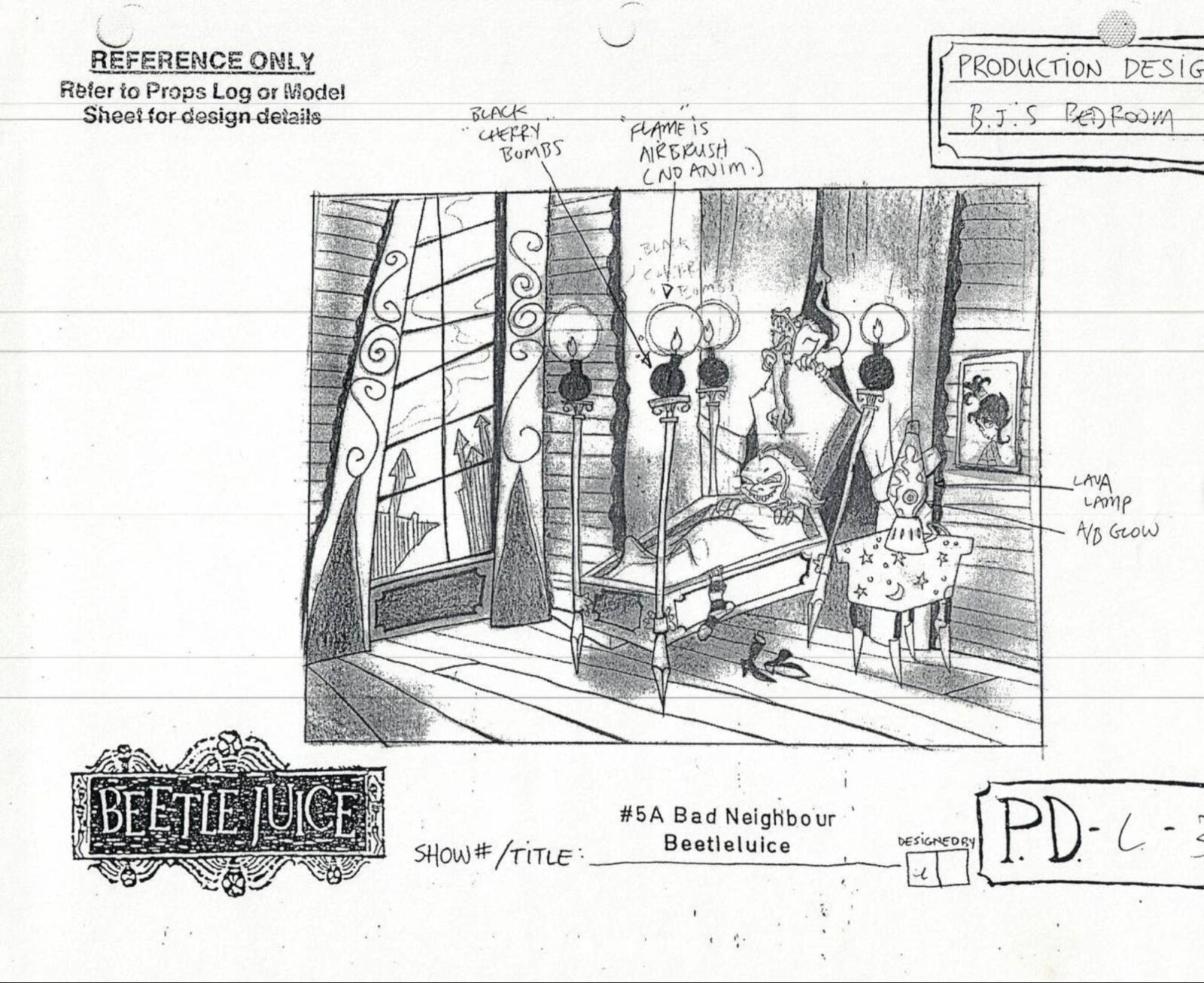
Budd: So many cartoons based on movies are just a slave to the original, and as a result, they feel like a pale imitation. We weren’t doing that. Of course, the film was a big influence, but we had other influences on the look, too, like Al Hirschfeld and The Cabinet of Dr. Caligari. I also love fluid animation and I love morphing things, so there’s a lot of that in there.
For Beetlejuice, the black-and-white suit was a must. It was a nightmare to animate because that’s very tough to track when something is hand drawn, but it was absolutely essential because those stripes are essential to who the character is. Stripes like that are tasteless and gaudy, and so is Beetlejuice. We also gave him misshapen teeth, and he was fairly ugly and balding. For a kid’s show, that was unusual at the time.
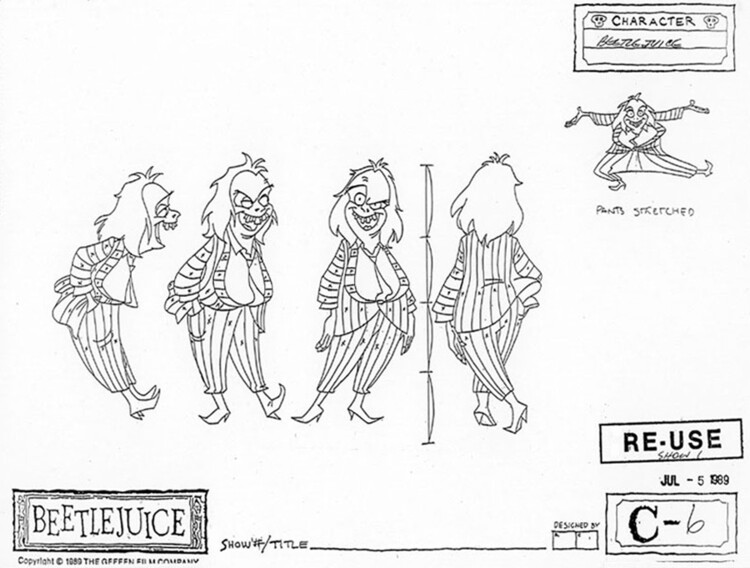
As for Lydia, we were influenced by the feature, but we wanted to simplify her and keep her physically delicate and beautiful in that goth way. I would have taken it even further, but we met with merchandising people and they talked about making lunch boxes and toothbrushes and all that stuff. I kept saying, “We’ll make everything black!” and they did not like that idea. Back then, merchandising people were super straight and conservative.
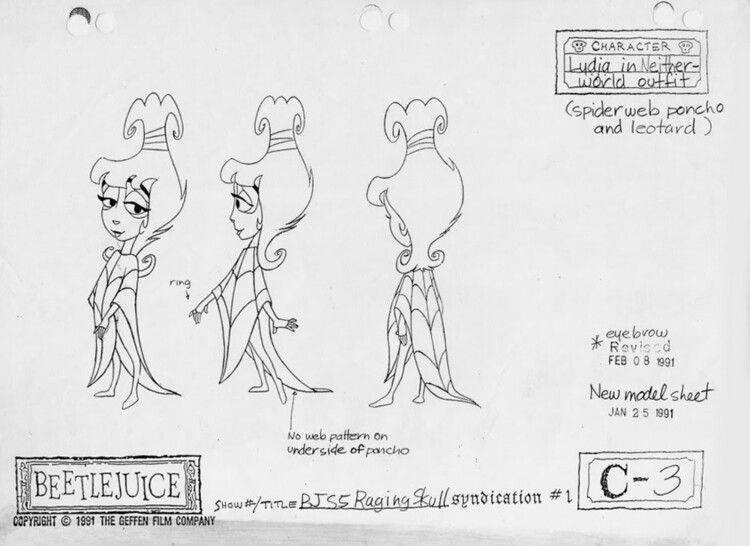
One of the big things from the movie to bring over was the look of the Afterlife, which we called the Neitherworld. I love that Tim Burton aspect of warping layouts and locations, where doors don’t fit and hallways are crooked. I also love textures like checkers and stripes — like a bad, retro-carnival approach. We tried to bring as much of that over as we could into our Neitherworld.
Once we had a package together, we flew to London and presented it to Tim Burton, who was still working on Batman. He hardly had any time, so we met him at his townhouse, and we presented him with all this artwork and ideas. He was exhausted, but he picked out some interesting things that really shaped the comedy of the show.
The most important thing was a drawing of Beetlejuice where his stomach was wide open like a mouth and the caption was, “I’m starving,” or something like that. Tim said, “That’s it! Go for something really literal. Make a pun and make something literal out of that visually.” That was the key to moving forward in an original way that was different from the film and friendly to 2D animation.
Cameron: Tim Burton had no ego whatsoever. He was genuine and supportive and had lots of ideas. Some of the characters we came up with with him. One was a tap-dancing skeleton my husband named Ginger after Ginger Rogers. There was The Monster Across the Street, and another one was a weightlifting skeleton named Jacques LaLean. I remember Tim said, “Every show has to have a French skeleton.”
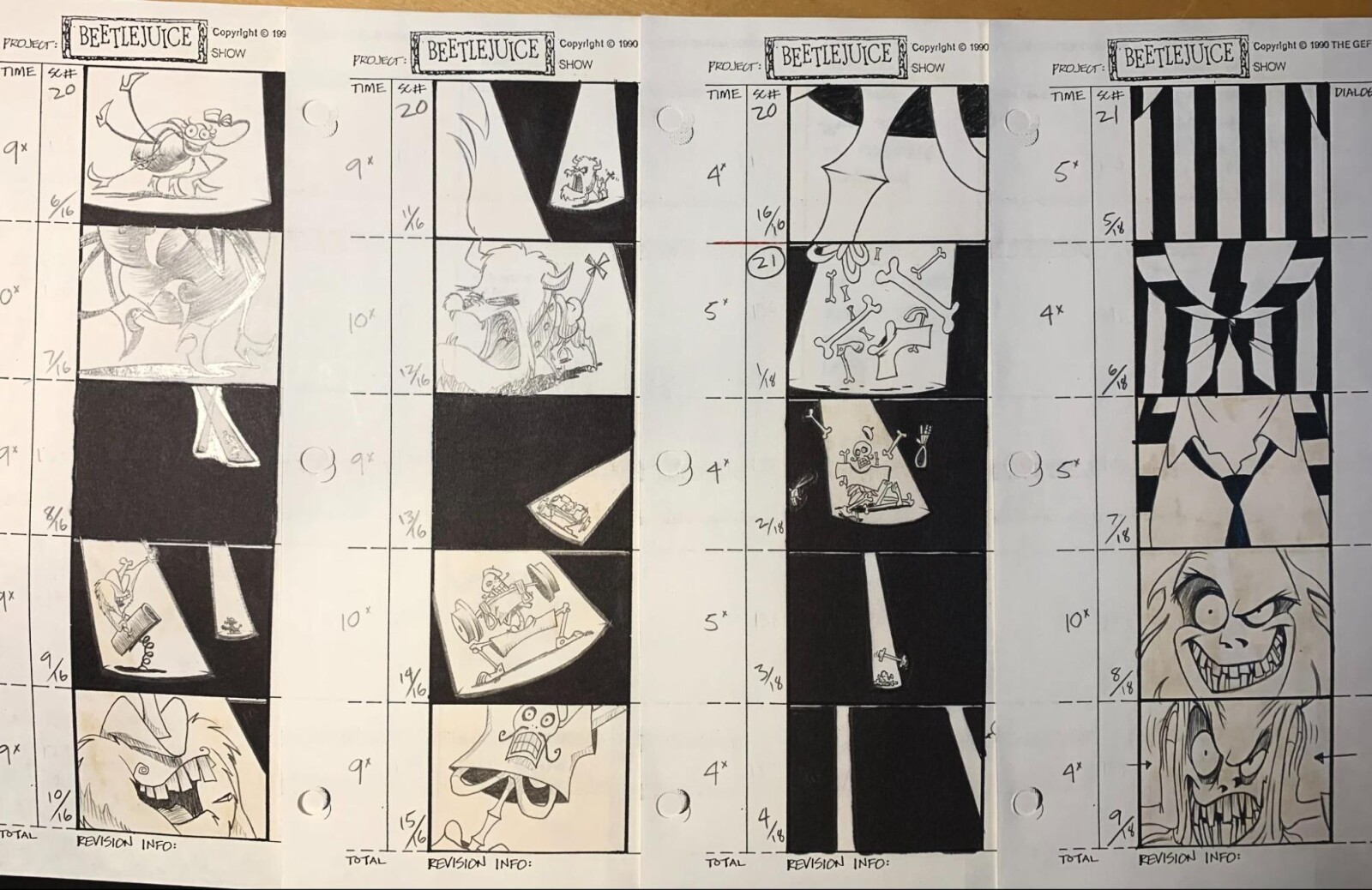
LaBonte: The Monster Across the Street was a design I based on a monster from Warner Bros. cartoons, Gossamer, while his dog, Poopsie, was based on a caricature I did of John Halfpenny. I morphed John’s face with a buffalo and a little dog. I put them all together and came up with this belligerent little dog. He was one of my favorite designs. I even got to do the barking for that dog.
Budd: I liked the character Barry MeNot. He was the computer-animated character done by a local studio called Caliber. Computer animation was so limited at the time that the character became extra creepy.
Hirsh: When we initially met with Tim, we had committed to putting in mixed media, which we did through early computer animation. This was the mid-1980s and computer animation wasn’t yet a common thing, but we did it.
LaBonte: In one episode, I had to design a director character, so I did this pretentious drawing of Tim Burton with his arms crossed. Tim Burton really liked that design. We were in constant communication with Tim Burton, especially early on, via faxes and phone calls. Initially, he just wanted to talk to us artists directly, but the producers cracked down on that.
One of my main interactions with him was when he came to town, and all of us ended up going to an executive producer’s party.
Smith: The funny thing was that the suits were all on one side of the room while Tim Burton was hanging out with me and Robin Budd and the other artists on the other side of the room.
LaBonte: The party kind of sucked, so Tim Burton came over to us and said, “Hey, this is kind of boring, you want to go somewhere?” I said, “Let’s go to my house!” I was renting this ramshackle house where all of my bands practiced. So he piled as many people as he could into his limo, and we all went into my house. The instruments were already set up, and everybody, producers included, tried to play music.
My most vivid memory was sitting on the basement stairs with Tim Burton as he was explaining the synopsis of Edward Scissorhands to me. At the end, he asked me, “What do you think?” and I said, “That’s the craziest thing I’ve ever heard.”
Voices from the Neitherworld
Merle-Anne Ridley, casting assistant, record assistant and producer on Beetlejuice: At first, we wanted people who sounded exactly like Lydia and Beetlejuice did in the movie, but we found that that didn’t quite work for the cartoon. The sound of this evil, creepy guy with this goth girl in the attic just felt off, so we realized we couldn’t do an exact match.
For Beetlejuice, Stephen Ouimette did eight in-person auditions for the role. At first, he did a perfect voice match with all the gravel and all the darkness, and it just felt creepy. So he gradually did something that was lighter and more comedic, and you suddenly felt okay with those two being in an attic alone together.
Alyson Court, voice of Lydia Deetz: There’s an innocent child aspect to Stephen Ouimette’s Beetlejuice, and that was the only thing that made it possible. Stephen found that balance where it’s still Beetlejuice, but it’s not threatening.
As for me with Lydia, I got the role when I was 15. I was obsessed with the movie, and I was dressing all in black. I studied Winona Ryder and got that deadpan voice down perfectly, and that’s what I did for my first audition.
That was right before Spring Break. They asked what my schedule was like, and I told them I was going to Florida to Disney World. They said not to worry about it, so I went. Then we got a phone call from my agent saying they wanted a demo tape, but I was in Florida with a terrible sunburn and I just couldn’t do it. They ended up recording the demo with Tara Strong, but it wasn’t gelling with Stephen and Tara, so they still wanted me to come in after I got back from Florida.
When I went into the booth, I started to do my Winona Ryder voice, and they said, “Lydia’s actually younger now, so you can do your natural voice.” I did it, but in my head I was like, “I worked so hard on this voice!”
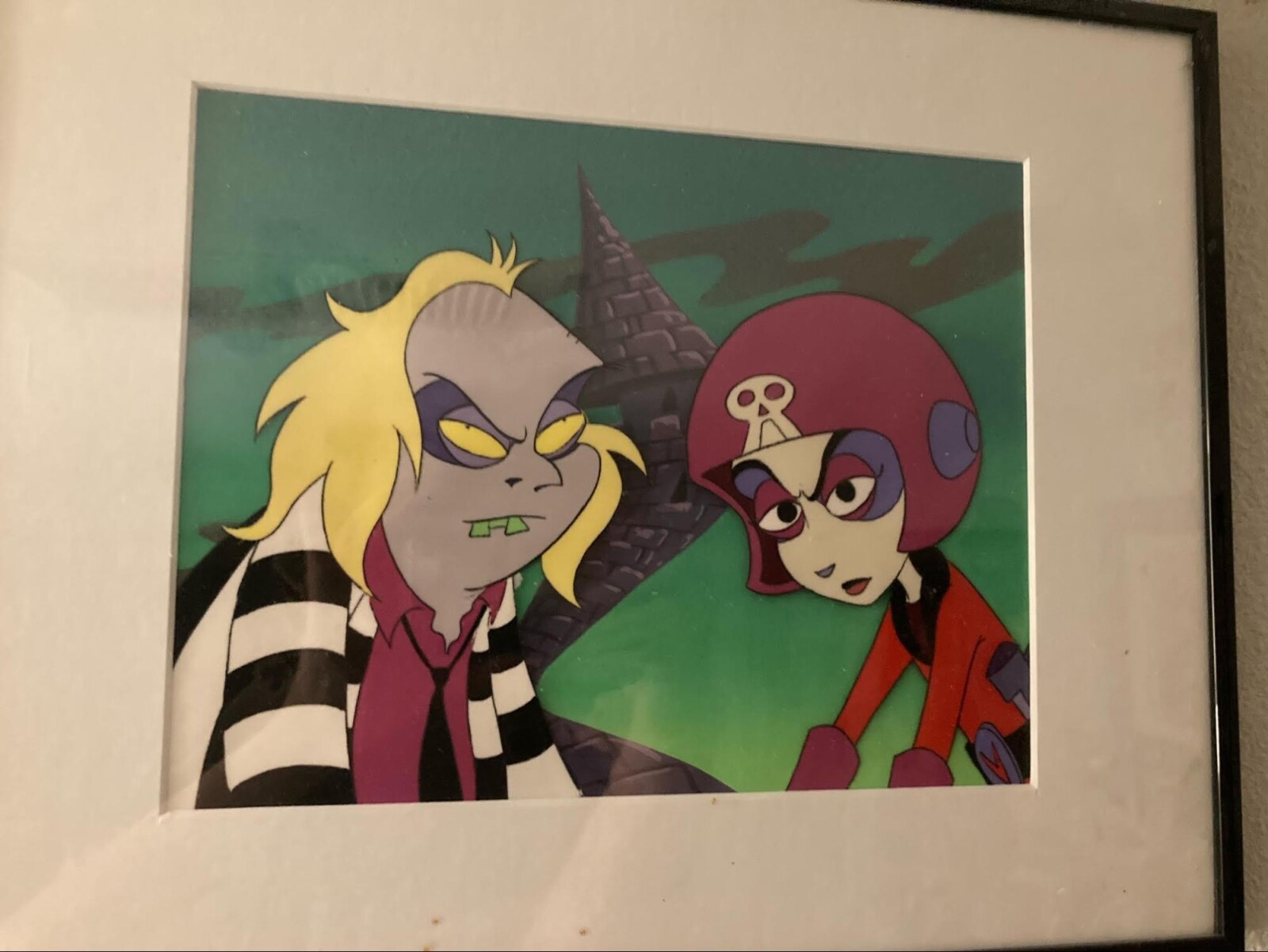
‘It’s Showtime!’: Beetlejuice on ABC
Court: When the show launched, there was a party at Michael Hirsh’s house, which just happened to be the night before my 16th birthday. At midnight, everyone sang “Happy Birthday” to me, including Tim Burton. Yeah, Tim Burton sang me “Happy Birthday” for my 16th birthday.
Cameron: The first season did really well in the ratings, and we won an Emmy. When we won, Tim told us, “I know this is because of you guys.”
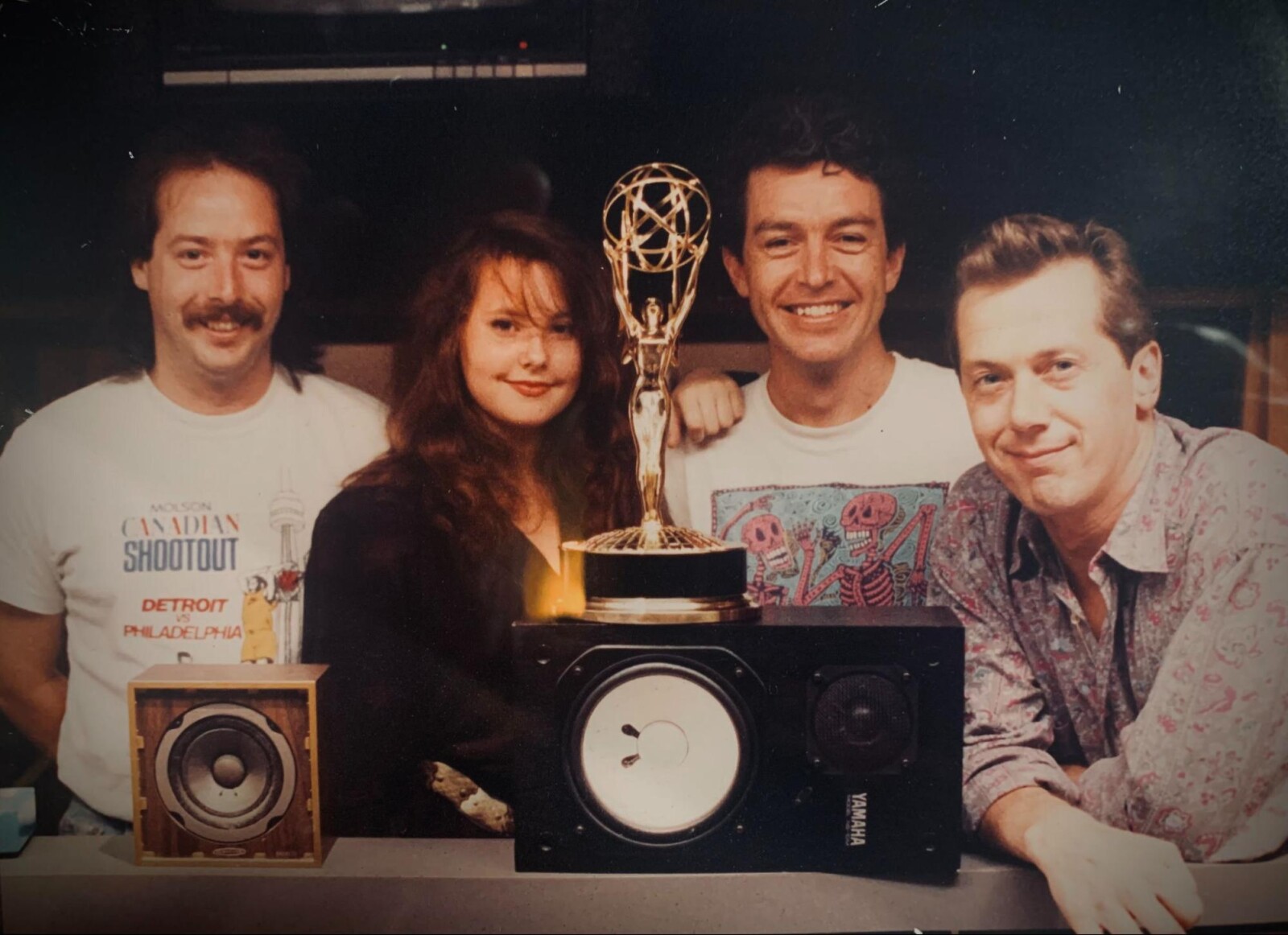
Tedd and I always had so much fun on that show, though we did have a couple of little issues with the censors for ABC. For example, we got a note once about Beetlejuice’s stinky feet. Another time, we got a note about Beetlejuice eating a beetle, which is something he did on the show all the time — Beetlejuice ate bugs. To deal with that one, Tim said to face it head-on, so we did this big, dramatic, drawn-out thing with Beetlejuice about to eat the beetle, then we had this giant “crunch!” off-screen. The censors eventually adjusted, but Beetlejucie was different for that time. Beetlejuice wasn’t cute and cuddly. It made fun of cute and cuddly.
‘Turn on the Juice and See What Shakes Loose’: Beetlejuice on Fox
Hirsh: The show was originally picked for ABC for Saturday mornings, but in their deal, Warner Bros. reserved their right to a syndicated strip running the show Monday through Friday, which is how Beetlejuice ended up on Fox Kids.
Margaret Loesch, former president and CEO of Fox Kids: In 1990, we had launched Fox Kids, and we were all working like dogs, trying to fill airtime because we had unknowingly overpromised what we could do for the affiliates. We had to fill four hours on Saturday mornings, then, during the week, we had two hours in the morning and two hours in the afternoon every day. I was pursuing Batman on behalf of Fox Kids, and during those discussions, Warner Bros. told me that they could make Beetlejuice available. We needed something for our Monday-through-Friday schedule, and my team and I just thought it was a good idea. We all loved Beetlejuice, and Warner Bros. offered us a deal with 65 new episodes. Starting in 1991, we put it on Monday through Friday while ABC did one more season on Saturdays.

Ridley: We had to deliver 65 episodes in 17 months, plus we still had eight more to do for ABC. It was insane. We went from recording one episode every two weeks to recording two-to-three episodes every week. The whole studio was on the project. We’d never had that much work in the studio.
Smith: With the 65-episode order, there was so much work to do that they had to hire multiple story editors. They were going to put me on Rosanne Barr’s show Little Rosie, but I refused — I wanted to do Beetlejuice. I’d written a few episodes already, and I wanted to do more. I told them I’d quit if they put me on Little Rosie. So I became the story editor on about 15 episodes, breaking stories with Tedd, Patsy and Tim Burton.
Sidney Iwanter, executive for Fox Kids: When Fox Kids got Beetlejuice, Margaret came to me and said, “Do you think we can do anything with Beetlejuice?” So I watched the shows ABC had done up until that point. I thought it had started out as gangbusters, but by the second year, it started to flame out. I told Margaret, “I watched those ABC Beetlejuices, and I think you could do far more with it. They were very Lydia-centric, they were very young and Beetlejuice had been almost a secondary figure that wasn’t even Beetlejuice.” This was typical of children’s programming back then, and ABC, which had very strict broadcast standards.
I told Margaret, “We can really liven up Beetlejuice if you just turn Beetlejuice into Beetlejuice. Which is why, if you look at our episodes as opposed to ABC’s, we’re wilder and wackier. We pushed the envelope in a way that had never been pushed before in children’s programming, which helped pave the way with what we were able to do later with X-Men and Batman.
Eric Lewald, story editor on Beetlejuice: Sidney and Margaret came to us writers and said, “We need to make this edgier and have it be more fun and push the envelope a bit.” All the writers smiled and said, “All right!” So Beetlejuice became a little older and a little edgier when it got to Fox.
For example, I did an episode called “Keeping Up with the Boneses” about Beetlejuice discovering the joys of credit card debt. Beetlejuice was even about to get his legs broken by mafia hitmen over his credit-card spending, which is a fairly adult problem. It had slightly more twisted and more adult humor that ABC wouldn’t have gone for. We got some angry letters because of it.
Iwanter: You had a lot of bible-thumpers who found that show satanic. I got a lot of letters from Baptist ministers about how satanic the show was and how we’d all burn in hell. Back then, though, you’d have to take those people seriously, so I couldn’t just ignore them.
I remember getting this one angry letter about a scene where Beetlejuice turned into a donkey from this one woman who was a Baptist minister in Texas. I called her up and spent an hour on the phone with her talking about the bible and all the animals — all the donkeys, jackasses and mules — associated with biblical stories. I had the bible in front of me, and we had this in-depth conversation. At the end of it, she said, “It’s nice to know you’re a god-fearing man, and I’m happy you’re attached to this show.” And that was it! You never ignore people, because then it just gets worse.
Loesch: Sidney got those angry letters, and he’d return them in-kind. He could be so sarcastic. I’m surprised someone hasn’t killed him.

Lewald: After I did my first episode for Tedd and Patsy, Sidney called me and told me, “Tedd and Patsy wanted to step onto something else. Would you like to run the last 20 episodes of Beetlejuice as the showrunner?” It was my first real network showrunning gig. Tedd and Patsy were still around as executive producers, but they were developing other stuff. The last 20 episodes were some of the wildest.
Smith: After that 65 episodes, we all hoped we’d do more because it was a fun show to work on, but I guess they felt like they had enough.
Loesch: After the 65 episodes were fulfilled, Beetlejuice was done because we already had a full run by that point. For a show to go beyond that, it would generally be because of licensing and merchandising. Beetlejuice had a toy line, but it wasn’t huge, so it wasn’t something that could sustain the show.
‘Go Ahead, Make My Millennium’
Iwanter: What stands out about Beetlejuice 35 years later is the originality of the series. That sort of mania could later be seen in subsequent shows from Nickelodeon and Cartoon Network in the 1990s. We broke the mold in that we proved you could go at that lunatic pace.
LaBonte: Beetlejuice affected a lot of shows that came after it. Even in-house at Nelvana, I worked on My Pet Monster after Beetlejuice, and there was an influence there. And any time I’ve worked in a new studio and they find out I worked on Beetlejuice, it’s a big deal. I’ve heard several animators say, “I got into animation because of Beetlejuice.
Smith: I wish they’d do more Beetlejuice cartoons now. I’d be all over it.
Ridley: They should totally reboot Beetlejuice, especially now that the new movie is coming out.
Court: Absolutely reboot it! Look at the sequel — from the trailers, they’re taking a page from the cartoon. They’ve learned that Beetlejuice can’t be the ultimate bad guy; they’re trying to soften him, just like the musical has done.
So yes, let’s reboot it. Get the same team back and let’s go!

